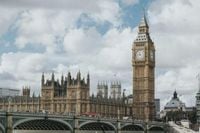British households and policymakers are facing renewed pressure as inflation in the United Kingdom surged to its highest level in 18 months, complicating the path for future interest rate cuts and underscoring persistent challenges in the cost of living. Official data released on August 20, 2025, by the Office for National Statistics (ONS) revealed that the Consumer Prices Index (CPI) rose by 3.8% in the 12 months to July, up from 3.6% in June. This marks the fastest annual rate since January 2024 and slightly exceeded most analyst forecasts, which had anticipated a rise between 3.7% and 3.8%.
The headline inflation figure places the UK at the top of the G7 economies for price growth, outpacing the United States, where inflation held at 2.7% in July, and the eurozone, where it remains closer to the European Central Bank’s 2% target. According to Reuters, the Bank of England (BoE) had expected this 3.8% inflation rate, but the persistent strength of price rises—especially in the services sector—has left the central bank in a tight spot.
Transport costs, particularly air fares, made the largest contribution to the monthly increase, the ONS said in its official release. Seasonal factors played a role, as summer travel and leisure demand typically push up prices in sectors like hotels and flights. The cost of petrol and diesel was nearly 3p per litre higher than a year ago, further straining household budgets and business costs. While gas and electricity prices dipped slightly at the start of July, any savings were quickly offset by increases in other bills, leaving families no better off.
Food prices, a major component of household spending, jumped 4.9% compared to the previous year—the largest rise since February 2024. As noted by the BBC’s cost of living correspondent, this spike is especially painful for lower-income households, who can’t easily cut back on essentials. “The cost of almost everything we buy has been creeping up again over the last year, adding pressure on a government who promised to make life better for working families,” they reported. The government now finds itself in the hot seat, as the rising cost of living threatens to overshadow its pledges to support working families.
Services inflation, a key metric watched closely by the BoE, accelerated to 5% from 4.7% in June. This exceeded both the BoE’s own forecast of 4.9% and the 4.8% consensus from economists polled by Reuters. Services inflation has proven especially sticky, fueled by wage growth—still running at about 5% year-on-year—and a relatively tight labor market. Economists point to structural changes in the UK workforce since Brexit as a factor making it harder for inflation to fall back to the BoE’s 2% target.
The BoE recently cut interest rates to 4% in August, but only after a narrow 5-4 vote among policymakers, reflecting deep divisions and uncertainty about how quickly borrowing costs should be reduced. “Today’s inflation data will reinforce the Monetary Policy Committee’s cautious approach to cutting interest rates going forward,” Martin Sartorius, principal economist at the Confederation of British Industry, told Reuters. “While inflation is projected to ease next year, the risk of second-round effects means that the MPC will not race to loosen policy in the near term.”
Underlying these inflationary pressures are broader shifts in the UK economy. The latest GDP figures, released by the ONS on August 17, showed real GDP growth slowing to 0.3% in the second quarter of 2025, down from 0.7% in the first quarter. Despite this slowdown, the services sector—which makes up 80% of UK GDP—remains a growth engine, expanding by 0.4% in Q2. Information and communication services rose by 2.0%, and healthcare by 1.1%, reflecting the UK’s pivot toward high-value, knowledge-based industries.
The pharmaceuticals subsector within manufacturing surged by 7.0%, outpacing growth in machinery and equipment. Construction, another bright spot, grew by 1.2% in Q2, buoyed by housing and infrastructure projects linked to the government’s Industrial Strategy. However, the production sector contracted by 0.3%, with energy supply down a striking 6.8%, highlighting the challenge of balancing decarbonization goals with energy security.
The GDP deflator—a broad measure of inflation in the economy—rose 0.4% on the quarter, bringing the annual rate to 4.1%, well above the BoE’s 2% target. This, combined with persistent services inflation and strong wage growth, signals that price pressures are unlikely to abate quickly. The BoE itself expects inflation to hit 4% in September and remain above 2% until at least mid-2027, a much slower return to target than in the U.S. or eurozone.
For investors, these dynamics present both risks and opportunities. According to AINVEST, equities in tech, healthcare, and clean energy are likely to benefit from the UK’s sectoral shifts, while inflation-linked assets such as Treasury Inflation-Protected Securities (TIPS) and real estate investment trusts (REITs) offer hedges against persistent price pressures. The UK’s post-Brexit trade strategy, with new agreements focused on services exports, could provide long-term growth potential, but vulnerabilities remain—particularly in goods trade and energy price exposure.
Currency markets have responded to these developments. Sterling initially dropped in late July and early August amid a period of U.S. dollar strength, but began to recover as that momentum faded. Still, the pound’s outlook remains closely tied to expectations for U.S. dollar weakness and the BoE’s policy stance. As Daniela Sabin Hathorn, senior market analyst at Capital.com, explained, “A sustained rally would require more than just a weaker dollar—it would need evidence of improving UK fundamentals, particularly in growth, and signs that inflation is easing in a way that doesn’t undermine monetary credibility.”
Employers also face higher costs, not just from inflation, but from a tax increase in April and a significant jump in the minimum wage, both of which have contributed to upward pressure on prices. Basic pay settlements in the private sector held steady at 3% for the eighth consecutive month, according to data firm Brightmine, but wage growth overall remains too high for the BoE’s comfort.
Looking ahead, the ONS is set to refine historical GDP estimates with the release of Blue Book 2025, offering a clearer lens for long-term trend analysis. Policymakers, investors, and households alike will be watching closely for any signs of relief from the current bout of inflation—or indications that it may persist even longer.
As the UK navigates this complex economic landscape, the challenge remains: how to balance the imperative of taming inflation with the need to support growth and protect living standards, especially for those most vulnerable to rising prices.







